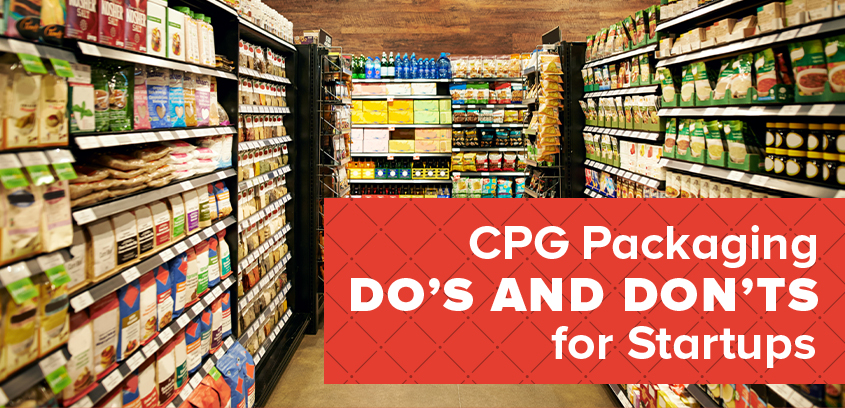
If you’re a start-up in the CPG (consumer packaged goods) world, you likely already know you’re entering a space filled with no shortage of competitors. The key to getting consumers to choose your product over a look-a-like? Eye-catching packaging – not just the way that it looks at retail, but also in how it functions and in the emotions it elicits. You have to think about what will resonate with your audience amidst a sea of similar goods. After all, when it comes to a crowded aisle or search engine results page, all you really get is one first impression – so don’t let it go to waste.
In fact, according to Inc., 95% of new products fail because most consumers judge them based on first impressions alone. No need to worry – Following this list of CPG do’s and don’ts to ensure your brand screams from the shelf tops.
Do
- Do research your industry and target customers to see what’s important to them. Do they trend toward certain color palettes or font styles? Is sustainability at the top of their list? Does emotional storytelling resonate with them? Are they focused on having inclusivity at the forefront of their purchasing choices? No matter how good you think your packaging looks, if it doesn’t line up with your desired consumer, then it won’t be effective.
- Do plan out your specific positioning before developing your project. How does your brand stand out from others in the market? How will you solve your customers’ problems in a unique way? Is it a message that goes against the grain? Is your method advanced in the industry? Are you planning to adopt an unexpected color palette? Find your “thing” and use it to your advantage in every touchpoint you have with your audience – starting with your packaging.
- Do consider the functionality of your packaging when designing it. The way your product’s packaging looks is obviously important, but you can take it to the next level with what you can actually do with it. Does it have a handle making it easy to carry? Grooves or joints built in to simplify its use? Can the packaging be used as a holder for your product beyond the initial purchase? Every small detail goes a long way in attracting and retaining customers.
- Do buy physical examples of packaging in your category to evaluate what you do and don’t like. This will not only spark ideas to help you visualize your product’s packaging, but it will also raise awareness for what already exists. Maybe you like the illustration design of one competitor, but really dislike the packaging material on another. You can handpick specific elements to formulate a packaging design that is unique to your brand.
- Do understand where your product will likely be distributed to plan appropriately. Are you planning to only sell in retail stores, and if so, which type? In a grocery, convenience store or in a grab-n-go cooler? Do you know what the shelves will look like? Considering these questions will help make sure your packaging fits with the vibe and clientele of your target retail outlets. Conversely, will your product only be available online? Then you may be able to get away with something on the modest side.
Don’t
- Don’t overlook your budget limitations. It’s important to be realistic in setting expectations so that you don’t get in over your head and design something that you won’t be able to afford long term. If you are on a tight budget, avoiding extra fold-outs, die-cuts, etc. can be an easy way to cut costs while maintaining your vision. On the flip side, sometimes you don’t want to spend so little per unit that your product feels cheap – It’s a balancing act that should always be top of mind.
- Don’t choose colors without researching the psychology behind them. Did you know that color improves brand recognition by 80%? Moreover, different colors innately spark different reactions in consumers. For example, red tends to make you feel hungry, yellow could make you feel anxious if used too much and blue can cause a feeling of calmness and relaxation. Always do your research before choosing a color to base your entire business off of to avoid the expense of having to redo your branding down the road.
- Don’t forget about what you legally should or shouldn’t say on your packaging. Especially if you are in the food and beverage or cosmetics markets, there are strict rules and regulations in regards to nutrition facts and the use of terms like “natural flavors” and “organic.” Check the USDA and FDA’s requirements and receive your certifications prior to designing your packaging to ensure everything is approved and in place. You never want to mislead your customers or get slapped with a fine from regulatory agencies.
- Don’t blend in. While it may be tempting to duplicate the packaging of a brand that you love or that is leading the industry, don’t do it! The last thing you want is to be considered the “off-brand” or “rip off” version of them. Create something new and exciting that will be impossible for consumers to ignore. Creative and out-of-the-box packaging goes a long way in grabbing attention.
- Don’t forget to think about how your sales team can leverage your new packaging. You may be aware of why you chose specific fonts, colors, messaging and functionality, but does your sales team? They’re the ones that will be responsible for getting your product on the shelves and telling your brand’s story to your retail partners. You should provide them with sales sheets and materials to leave behind at retailers so that it’s easy for decision-makers to fully absorb what makes your product different.
Entering the consumer packaged goods market can be intimidating, but if done right, can be extremely rewarding. At Brew, we’ve perfected it through the art of product storytelling that ignites differentiation, creates engagement and sustains preference over like-minded products. Learn more about our CPG services here.

